
Features
Education
Event Reports
Heavy Equipment
Record-breaking attendance as CONEXPO-CON/AGG returns
CONEXPO-CON/AGG breaks all-time attendance level
April 24, 2023 By Andrew Snook
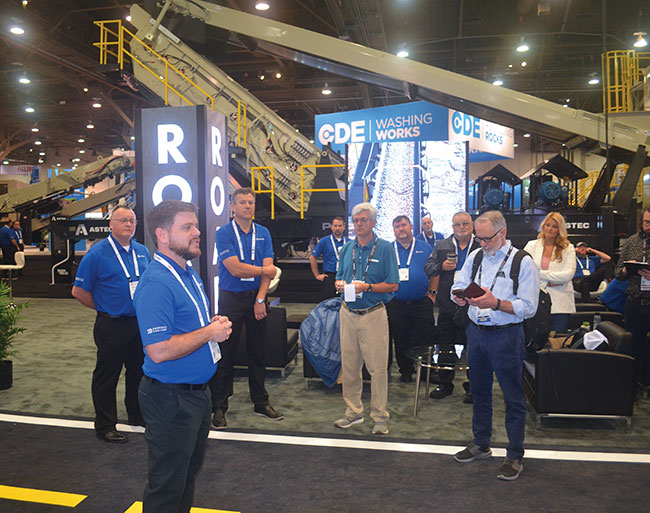
There was certainly no pandemic hangover at the 2023 edition of the CONEXPO-CON/AGG show in Las Vegas this past March. In fact, it was quite the opposite. The triennial show rebounded from the 2020 edition of the show (when the COVID-19 coronavirus pandemic was declared mid-show) in incredible fashion with a record-breaking 139,000 in attendance. This year’s edition of the largest constriction trade show in North America certainly lived up to its name, with companies showcasing new equipment across more than 3 million square feet off indoor and outdoor exhibit space.
The event had more than 24,000 international attendees registered from 133 countries. The educational component from the show had more than 91,000 badge scans from people attending various sessions.
The next edition of CONEXPO-CON/AGG will take place from March 3 to 7, 2026 at the Las Vegas Convention Center in Las Vegas, Nev.
To learn more about some of the thousands of technologies on display, Rock to Road spoke with various manufacturers active in the roadbuilding and aggregate industries. Here’s what they had to say.
FOSSIL-FREE STEEL
With global warming a major concern around the world, companies are trying to find innovative ways to reduce their CO2 emissions. Swedish steel manufacturer SSAB is one of the companies leading the charge.
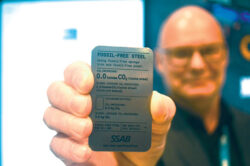
SSAB Stenx product manager
Magnus Carlsson displays a piece of
SSAB’s fossil-free steel at
CONEXPO-CON/AGG 2023.
SSAB Stenx product manager Magnus Carlsson explained that steel isn’t the primary product created in the traditional steel-making process.
“Steel is actually a byproduct, because for every one tonne of steel we make, we make 1.6 tonnes of CO2, and SSAB has the cleanest operations in the world today,” he said, adding that some other steel manufacturers around the globe produce as high as 2.5 tonnes of CO2 for every one tonne of steel. “Just our company produces 10 per cent of the CO2 emissions in Sweden, which, of course, is not acceptable. So, we are switching to fossil-free operations.”
In traditional steel manufacturing, iron ore is converted into iron ore pellets, and then is placed into a blast furnace. In this process, the iron ore creates excess oxygen that needs to be removed from the steel-making process.
“So, how do you take it away? You’ve traditionally put in carbon and coke and mixed it with limestone in a big furnace. And then, the carbon reacts with the oxygen, and then you get CO2,” Carlsson explained.
In the new steel-making process, known as HYBRIT technology, SSAB still uses iron ore and iron ore pellets, but instead of going into a traditional furnace, the pellets are heated up using a combination of fossil-free electricity and hydrogen. The oxygen gas reacts with the hydrogen and the process produces water and hydrogen instead of CO2.
The electricity being utilized in this process in Sweden comes from a combination of water power, wind power, and a small amount of nuclear energy. SSAB is in the process of replacing the furnaces in its mills with the hydrogen-fuelled technology.
“It’s quite costly and takes a lot of new equipment, but the properties of the steel will be same,” Carlsson said.
The technology being used in this process isn’t new, it’s been around for decades.
“It’s been around since the 1980s, but not at an industrial scale,” Carlsson explained.
In August of 2021, SSAB introduced its first fossil-free steel based on HYBRIT technology to a customer. The company plans on introducing various steel grades to market at an industrial scale using its fossil-free technology starting in 2026 with two new production facilities operating solely using this manufacturing process by 2030.
“It’s a little more expensive than making it as we do today, but so what. We cannot continue to introduce this amount of carbon dioxide, it’s not possible. Where will we end up?” he said.
ONE ASTEC
CONEXPO-CON/AGG marked the first time that all of Astec’s product offerings were on display under the OneAstec brand. The company has impressive displays totalling 30,000 sq. ft. of indoor exhibit space, as well as another 8,000 sq. ft. of outdoor exhibit space.
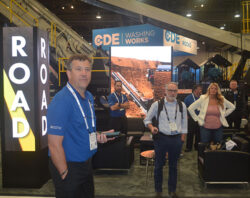
Astec’s new president and CEO
Jaco van der Merwe kicked off the
company’s press event.
Astec’s new president and CEO Jaco van der Merwe kicked off the company’s CONEXPO-CON/AGG press event.
“Obviously CONEXPO is always a nice place to bring new products out. But this year, we are very excited about some of the equipment that we brought out, especially some of the new paving equipment and some of the new milling equipment that opens a very specific market segment for us,” he said.
Two of the products debuted were Astec’s new generation of highway class RP Pavers, the RP-175 and the RP-195 series track pavers. The new pavers were designed to offer simpler maintenance with features like new lightweight hoods and a redesigned track system. The pavers were also built with the operator in mind with a new, single fan cooling system (replacing a dual system) that allows the machines to run quieter and has been repositioned to the top of the machine, blowing away from the operator and ground crew.
The company also had its full Astec Digital suite on display at the show. Over the past few years, Astec acquired Minds Automation Group and Grathwol Telematics to enhance its portfolio of digital solutions.
“Personally, I’m very excited about the platform that we’re busy developing in line with our rock-to-road philosophy. We will definitely be one of the suppliers in the industry that can supply our customers with digital solutions all the way from a quarry to the end product when we lay down a road,” said van der Merwe.
Leading the charge for digital solutions is Eric Baker (page 12), who was recently named vice-president of Astec Digital.
“We’ve got a lot of integration work to do with our acquisitions, we’ve got a great product portfolio and a lot of extremely skilled and knowledgeable people on the team. I’m really excited to lead that team,” Baker said, adding that Astec Digital solutions are all about connectivity and driving all the controls that live on the equipment and plants, and bringing that into the cloud and giving access to their customers so they can leverage the rock-to-road value chain into a competitive advantage for themselves.
Astec Digital had a few different product offerings on display. The company’s basic telematics offering, which is designed as a high-level asset management tool, allows fleet managers to view where machines have been working and travelling and idling, maps of entire fleets and additional tools for managing alerts.
“We can set up things like alerts for precipitation, sever faults and start work alerts,” explained Jacob Rich, project manager for Astec. “The weather thing is really cool. It’s the best weather data you can get, and it gets right into the location of your machine. So, if you’re paving out in the middle of nowhere, it’ll get you a forecast based on your location, not on the nearest city. So, you’re always sure that if you’re cancelling for rain, it’s actually going to happen.”
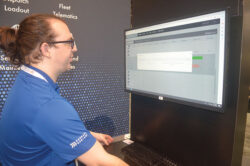
Astec project manager Jacob Rich takes Rock to Road through some of the features of Astec’s basic telematics offering, which is designed as a high-level asset management tool.
The Guardian System was also on display, which allows users to view almost any switch or sensor on a machine in real time. The system is designed to be the closest thing a customer can get to a mechanic bringing their laptop out to a site.
“Through our web interface, we use it for our own service techs to diagnose problems. One of the big features of it is that sometimes there’ll be something wrong with the machine that’s a really easy fix, and they don’t want to pay a service tech $160 an hour, or whatever it costs, to drive out,” explained Astec’s Anthony Cattano, adding that sometimes the service technician can be six to eight hours away. “There have been situations where it was something as simple as a circuit breaker, and you just tell the operator what circuit breaker number it is.”
The system is also effective for providing preventative maintenance solutions that help prevent downtime.
“If we can tell them that a part is going to go out in the few weeks or month, then they can order those parts beforehand through the dealer. We are connected to our dealer network, so they will have that information available to contact the end user,” Cattano said.
NEVER IDLE
John Deere and the Wirtgen Group held its largest joint press event since Deere acquired Wirgten in 2017 for $5.2 billion. The two companies showcased their joint offerings across 70,000 square feet of outdoor exhibit space and an additional 10,000 square feet of indoor exhibit space.
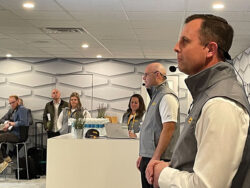
John Deere’s Jason Daly and Ryan
Campbell discuss the company’s latest equipment during a press event at CONEXPO-CON/AGG 2023.
Ryan Campbell, president of the construction and forestry division at John Deere Power Systems, kicked off the press event by discussing this year’s theme, “Never Idle.”
“What does that mean? Here at John Deere, we’re always listening, learning and innovating on behalf of our customers. We all understand the ever-increasing challenges our customers face and getting their essential work done. We are committed to making investments in technology, service and support of our world class dealer network, and our industry-trusted equipment to make their jobs easier. We understand that our customers’ work doesn’t stop and neither can we. We’ll build machines and solutions that are smarter, safer and more sustainable. No matter the size of the job, ’Never Idle’ is about the confidence of knowing that John Deere has your back.”
During the press conference, Jason Daly, vice-president of production systems, marketing and sales at John Deere, discussed a few new solutions including the Deere 904 P-Tier wheel loader equipped with the company’s new SmartWeigh payload weighing solution.
“This solution will deliver industry leading accuracy and dynamic weighing capabilities with ease of calibration,” Daly said. “What does that really mean for customers? What it’s going to mean for our operators is that the customer is going to have simplicity. Customers are going to know the weight of the bucket each and every time. They’re going to know the weight of the material in the bucket. They’re going to know what product is coming back in carryback, so that the customers can charge that out to their customers, and ultimately, control the costs on the job site.”
Daly also discussed Wirtgen’s AutoTrac automation technology for the WR Series for cold recyclers and soil stabilizers.
“On our recyclers, it’ll minimize the double passes and will minimize the overlap that we’ll see on job sites. This will result in less fuel and less binder material being used, allowing customers to get the jobs done sooner and save costs along the way,” Daly said.
Luke Dribble, solutions marketing manager for John Deere, discussed the features of the Deere 1050 P-Tier dozer.
“There’s been a couple of improvements that have helped gradability and balance to that machine,” he said. “We’ve actually introduced a solution that brings the blade a lot closer to the body of the machine. This machine also has our double-bogie undercarriage system on it that really improves ride quality. In fact, it reduces in-cab vibrations by up to 75 per cent.”
The 1050 P-Tier dozer is equipped with a JD14 engine and the hood has been redesigned for improved operator visibility.
“Ease of use has also been enhanced on that machine. There’s less hand movements required when changing directions, and we’ve added transmission presets that allow operators to switch back and forth more efficiently,” Dribble said.
Deere also introduced its new E-Drive (hybrid-electric) prototype machines at CONEXPO, which included the 744 X-Tier wheel loader. Dribble discussed the electric variable transmission and how it is what allows the machine to be a “true E-Drive solution.”
“There are two electric motors, an inverter and high-voltage cables on that machine, and that’s really what manages the needed torque and ground speed and range for what a customer demands of this machine,” Dribble explained. “Whether it’s loading trucks, going into piles, or whatever it’s doing on a typical aggregate site, those motors and inverter are able to efficiently manage the power, which is directly fed from the engine, and from there, sent directly to the ground of the machines.”
Deere hopes to bring at least 20 electrified machines to market by 2026.
Meeting customer needs
Komatsu chairman and CEO Ron Schrader spoke to the press during the show about meeting the needs of customers by building equipment that focuses on addressing sustainability, labour shortages and more.
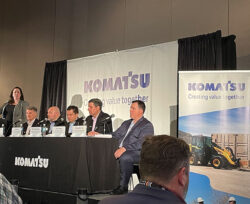
Komatsu’s executive management team, including chairman and CEO Ron Schrader talk about the company’s latest solutions, which address sustainability, labour
shortages and more.
“As sustainability rises in importance, the need to remain safe and highly productive does not fall away. The challenges of labour shortages and a lack of trained operators and technicians further complicates things. I think the key question is how can our customers do more with less, more sustainably, without sacrificing their bottom line?” Schrader said. “People are looking at these challenges within the buckets of technology, innovation, sustainability goals and labour challenges.”
He said Komatsu sees opportunities to consistently support its customers by leveraging technology, automation, training, and a mix of on-machine and cloud-based solutions that are aligned to what customers need to stay profitable, work sustainably and find and retain a strong workforce.
“We are displaying a wide mix of tools to help our customers continue, or start, the advancement of these pursuits – effective technology implementation, more sustainable ways of working and optimizing their work,” Schrader said.
Michael Gidaspow, vice-president of products, service and solutions, discussed how Komatsu Smart Construction marks a fundamental shift in the company’s view, moving from a machine perspective to a jobsite perspective, and understanding how all the equipment fits into the total picture.
“Helping customers shift from manual, disconnected processes to digitally connected, allows not only improvement within these individual processes, but a digital transformation across the organization as they start to see all the data in one place,” Gidaspow said. “Through the combination of smart construction solutions supported by telematics via My Komatsu, and the capabilities of intelligent machine control, customers can start to see larger opportunities for change, resulting in cost savings, more efficient use of time and equipment and increased productivity.”
He added that there are currently tens of thousands of workplaces globally using Komatsu Smart Construction and IMC (intelligent machine control) tools to enhance their equipment use and operational effectiveness.
Gidaspow said the aggregate sector is ripe for the adoption of innovative digital solutions, and discussed Komatsu’s Smart Quarry portfolio of solutions. The Smart Quarry portfolio has three offerings the company is promoting. The first is Study, which provides predictability for an optimal fleet recommendation.
“Komatsu experts analyze the customer’s operation and recommend fleet or operational changes to help the customers meet their goals. Think of it as a snapshot consultation,” Gidaspow said. “Next, with either a smartphone app or a low-cost telematics device, we can track a piece of equipment’s position over time to visualize load counts, cycle times, idling, inefficiencies, and providing effective fleet management and an overview of productivity from a hauling perspective. This solution is so flexible, it’s easily at home on both construction or quarry sites.”
He then discussed Komatsu’s Site solution, which features dedicated hardware installed in any major model of machine.
“This brand-agnostic site management solution offers an in-depth understanding of production, fuel consumption, idle time, operator performance and more. Super powerful and comprehensive, there’s isn’t a quarry or aggregate operation we don’t think that benefits from this tool,”
Gidaspow added.
Acquisitions and electrification
Terex had 15 machines on display for CONEXPO, nine of which were brand new models since the 2020 edition of the event.
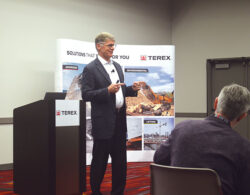
Terex president John Garrison speaks to reporters at the company’s
CONEXPO-CON/AGG press conference about the Terex’s most recent
acquisitions and future goals.
“Innovation is critical for us as we go forth bringing new products and services to the marketplace lifecycle development,” Terex president John Garrison told reporters at the company’s CONEXPO-CON/AGG press conference. “We produce capital goods that last for a long time that interface with the customer throughout the lifecycle of that piece of equipment or that solution.”
Garrison touched on the importance of the continued electrification of equipment.
“It’s picking up steam everywhere. If you look at a company like us, about 60 per cent of the products that the [Terex] MP segment produces are offered in some form of either hybrid, or electric. And about 70 per cent of our Genie products are offered in some form of hybrid or electric – that train is leaving the station and it’s accelerating as we go forward,” he said.
Garrison also discussed Terex’s acquisitions since the 2020 show, which includes Canadian company ProAll, based in Olds, Alta., which specializes in the production of mobile volumetric concrete mixers in 2021. That same year, Terex also acquired a new manufacturing facility in China for the production of Powerscreen equipment for the Chinese domestic market.
In 2022, Terex also acquired Steelweld Fabrications, a manufacturer of heavy fabrications for the production of parts for the company’s crushing and screening products; and purchased the assets of ZenRobotics Ltd., a company that manufactures robots that pick, sort, and recycle waste material.
During CONEXPO-CON/AGG, Terex Materials Processing (Terex MP) also announced that Terex Cranes would be split into two divisions: Terex Tower Cranes and Terex Rough Terrain Cranes.
“Since they are two completely different set of products, manufactured in two independent facilities, it makes sense to separate them to provide more focus and clarity. We have new brand identities for Terex Tower Cranes and Terex Rough Terrain Cranes and each business now has its own individual general manager who will execute independent growth strategies—broadening their specific product portfolio and expanding distribution partners for those products globally while enhancing support for their distribution network,” Terex MP president Kieran Hegarty later stated that in a press release. “We see a lot of potential for Terex Tower Cranes and Terex Rough Terrain Cranes.”
Part 2 of the CONEXPO-CON/AGG Show Report will be published in the May/June issue of Rock to Road
Print this page